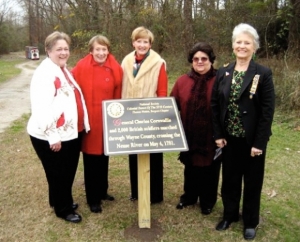Marker notes Cornwallis' crossing
By Dennis Hill
Published in News on December 27, 2009 1:50 AM

Submitted photo
From left, Mary Ann Hepler, state chairman for marking and preservation of historic Sites sites for the Carolina Society of Colonial Dames, XVII Century; Emily Weil, president of the Thomas Wotton, Surgeon Chapter of the organization; Emmy Mitchell, chapter chaplain; Nell Garner, chapter vice president; and Jean Haislip Clay, chapter secretary.
A little known Wayne County historical fact is that during the Revolutionary War, British Gen. Charles Cornwallis passed through the county on his journey that eventually wound up in Battle at Yorktown and the birth of our nation.
Historians have well documented the activities of Cornwallis across North Carolina, especially the Battle of Guilford Courthouse in Greensboro late in the war.
After leaving Greensboro, Cornwallis' army moved southeast to the port city of Wilmington.
Then, realizing that his next destination likely would be Yorktown, Va., Cornwallis headed north.
However, the swampy woods of eastern North Carolina posed a big problem.
Strong footing was especially needed in order to move wagons and heavy artillery over the wet lowlands.
In crossing the Neuse River, Cornwallis, as he moved northward through what would eventually Wayne County, he chose a point near what would become the Village of Waynesborough. The site is just west of the present-day city of Goldsboro.
On May 4, 1781, the British forces under Cornwallis's command made that crossing.
Research to prove that the maneuver was made by conducted by the Thomas Wotton, Surgeon Chapter of the National Society Colonial Dames XVII Century, which has members from Mount Olive, Fremont, Kinston, Greenville, Winterville and Stantonsburg, as well as Goldsboro.
Placing an historical marker at the site was approved by the state and national historical societies and a sign was recently erected denoting the date and historical significance of the crossing of the river.
